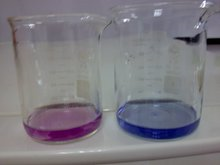Volatile base nitrogen (TVB-N) refers to an animal food that, due to the action of enzymes and bacteria, decomposes proteins during the process of spoilage to produce basic nitrogenous substances such as ammonia and amines. Such materials are volatile, the higher the content, indicating that the more amino acids are destroyed, especially methionine and tyrosine, so the nutritional value is greatly affected. Volatile base nitrogen (TVB-N) refers to animal foods that, due to the action of enzymes and bacteria, decompose proteins during the process of spoilage to produce basic nitrogenous substances such as ammonia and amines. Such materials are volatile, the higher the content, indicating that the more amino acids are destroyed, especially methionine and tyrosine, so the nutritional value is greatly affected. Determination of volatile base nitrogen (TVB-N) Semi-micro nitrogen method (1) Principle: Protein decomposes under the action of enzymes and bacteria to produce basic nitrogenous substances, such as ammonia, primary amines, secondary amines, etc. These substances are volatile and can be distilled out in alkaline solution. Standard acid titration, calculate the content. (2) Reagents 1 Magnesium oxide suspension 22% boric acid solution (absorbent) 30.2% methyl red ethanol solution 40.1% methylene blue aqueous solution When used, mix 34 equal amounts into mixed indicator solution 50.0100N hydrochloric acid standard solution or 0.0100N sulfuric acid standard solution. (3) Instruments 1 semi-micro nitrogen device: Markhan's formula 2 micro-burrator: minimum index of 0.01ml (4) Method of operation Preparation of 1 sample: After removing the fat, bones and tendons from the sample, chop and stir well, weigh 10g into the conical flask, add 100ml of water, shake it from time to time, immerse for 30min, filter, and put the filtrate in the refrigerator. . 2 Determination: In advance, a conical flask containing 10 ml of the absorption liquid and 5-6 drops of mixed indicator liquid was placed at the lower end of the condenser tube, and the lower end was inserted into the liquid surface absorbed in the conical flask, and 5 ml of the above sample was accurately taken. The filtrate is placed in the retort reaction chamber, 5 ml of 1% magnesium oxide suspension is added, and the suspension is quickly closed, and water is added to prevent leakage, and steam is introduced. When the steam is filled in the distiller, the steam outlet pipe is closed, and the cold parallel tube appears. The first drop of condensed water starts to be counted, and the distillation is stopped after 5 minutes of distillation. The absorption liquid is titrated with 0.0100N hydrochloric acid standard solution or 0.0100N sulfuric acid standard solution, and the end point is blue-violet. At the same time, do the reagent blank test. (5) Calculation (V1-V2)×N1×14 X1= ------------------------- ×100 M1×5/100 Where: X1--the content of volatile base nitrogen in the sample, mg/100g V1--measurement sample consumption of hydrochloric acid or sulfuric acid standard solution volume, ml V2--Reagent blank consumes hydrochloric acid or sulfuric acid standard solution volume, ml M1-concentration of N1--hydrochloric acid or sulfuric acid standard solution, mol/L M1--sample quality, g 14--1N hydrochloric acid or sulfuric acid standard solution 1ml equivalent milligrams of nitrogen 2. Micro-diffusion method (1) Principle: The volatile nitrogen-containing substance is released in an alkaline solution, and is volatilized in a diffusion dish at 37 ° C and then absorbed in an absorption liquid, and titrated with a standard acid to calculate the content. (2) Reagents 1 Saturated potassium carbonate solution: Weigh 50g of potassium carbonate, add 50ml of water, slightly heat and help dissolve, and take the supernatant when using. 2 Water-soluble glue: Weigh 10g of gum arabic, add 10ml of water, add 5ml of glycerin and 5g of anhydrous potassium carbonate (or anhydrous sodium carbonate), and evenly mix. 3 Absorbent: Mix indicator solution, 0.0100N hydrochloric acid or sulfuric acid standard solution, same as semi-micro nitrogen method. (3) Instruments 1Diffuse dish (standard type): vitreous, total diameter of inner and outer chambers is 61mm, inner chamber diameter is 35mm; outer chamber depth is 10mm, inner chamber depth is 5mm; outer chamber wall is 3mm, inner chamber wall is 2.5mm, back wall is thick glass The cover, as shown in Figure 1-1, can also be used with other models. 2 micro burette: minimum division of 0.01ml. Method of operation 1 Apply water-soluble glue to the edge of the diffusion dish, and add 1 ml of the absorption solution and 1 drop of the mixed indicator solution to the inner chamber of the dish. Add 1.00ml of the sample solution prepared by the semi-micro-nitrogen method to the side of the outer chamber, and add 1ml of saturated potassium carbonate solution to the other side. Be careful not to make two drops of contact, cover immediately; seal the dish on the table. Rotate to mix the sample with the lye. 2 Place the diffusion dish in a 37 ° C incubator for 2 h, remove the lid, and titrate with 0.01 N hydrochloric acid standard solution or sulfuric acid standard solution. The end point is blue-violet. At the same time, do the reagent blank test. Figure 1-1 Microdiffusion dish (standard type) Description 1 should be carefully added when adding potassium carbonate, do not splash into the inner chamber. 2 The diffuser should be clean and dry without acid or alkali. 3 Both the sample test and the blank test are required to perform 2 parallel tests. 4 calculation (V3-V4)×N1×14 X2= ------------------------- ×100 M1×100/5 Where: X2--the content of volatile base nitrogen in the sample, mg/100g V3--measurement sample consumption of hydrochloric acid or sulfuric acid standard solution volume, ml V4--Reagent blank consumes hydrochloric acid or sulfuric acid standard solution volume, ml M1-concentration of N1--hydrochloric acid or sulfuric acid standard solution, mol/L M1--sample quality, g 14--1N hydrochloric acid or sulfuric acid standard solution 1ml equivalent milligrams of nitrogen Operation Connecting Stretcher Hospital Stretcher,Operation Connecting Stretcher,Medical Operation Connecting Stretcher,Hospital Operation Connecting Stretcher Jiangmen Jia Mei Medical Products Co.,Ltd. , https://www.jmmedicalsupplier.com